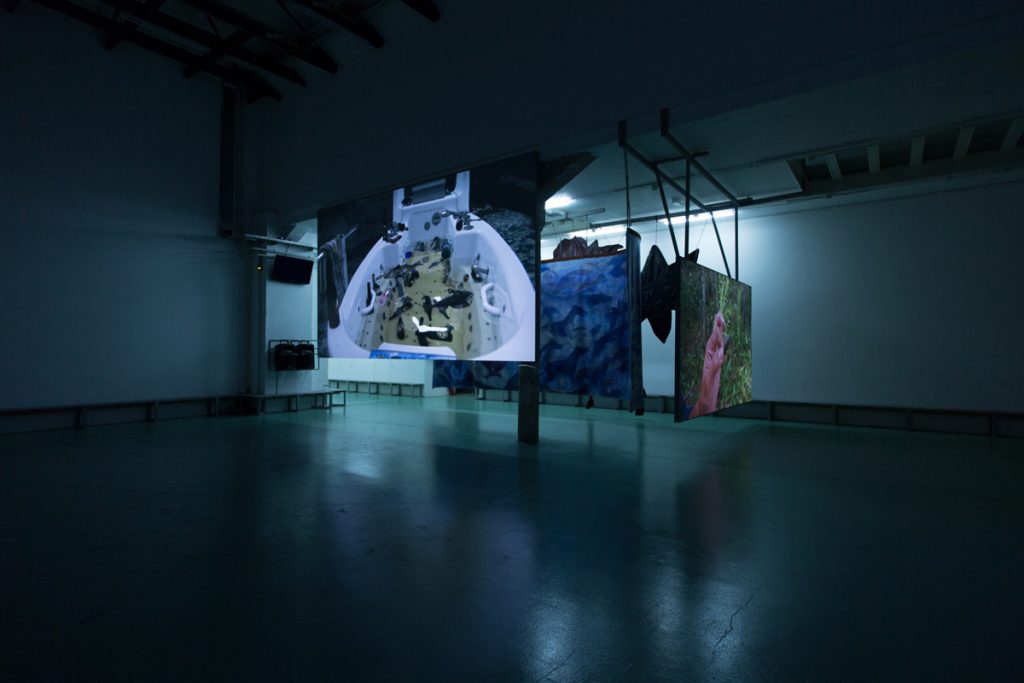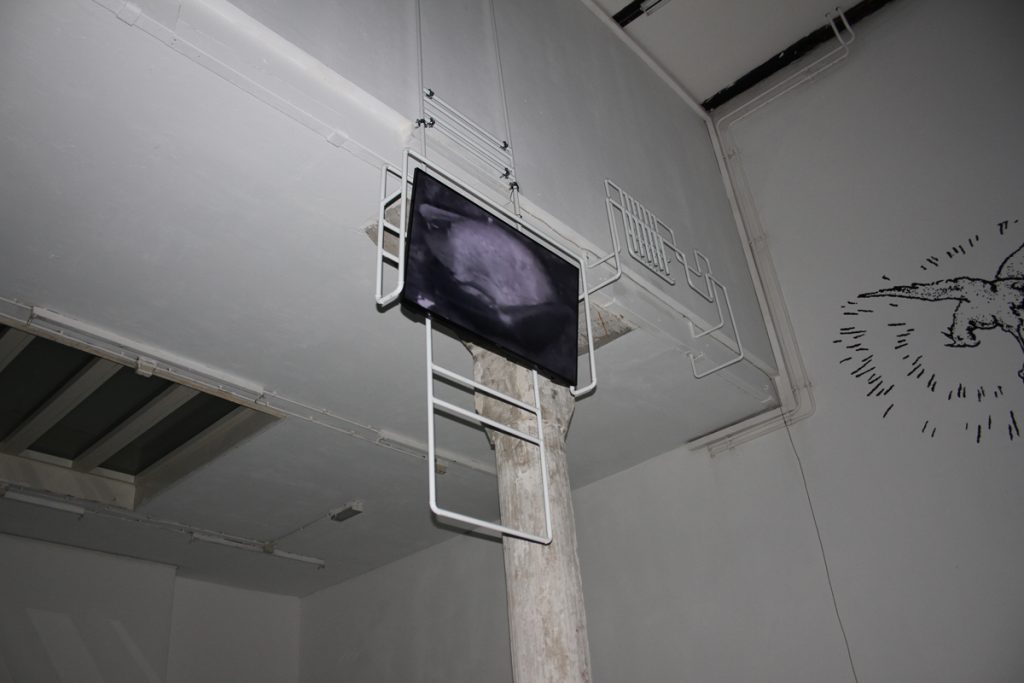
After fifteen hours on the Newcastle-Amsterdam ferry I was hungover for ‘Over hang’ at W139. I arrived, then, in the dual traditions of ‘creatives’ who’ve found that a bastard behind the eyes enables a more corpuscular encounter with art and tourists ruining Amsterdam for the locals. Or maybe, as this show, curated by exhibiting artist Dan Walwin, plausibly evokes, our current technologically-enabled post-human world is one unshakable hangover of customs, habits and feelings. On this complicated, junked planet, there are so many reasons to reimagine life and to entertain pastoral fantasies.
At the gallery entrance, marked by a felt drape embroidered clumsily with the title ‘over hang’, Jacob Dwyer’s soundwork, Keith’s Arcadia (2017), grounds the show in that mythical land. A sleight of the psychotic-geographer, its setting is not, however, the Peloponnese mountains but a Croydon shopping centre besieged by a rioting mob that’s already kicked in a betting shop. As the mob advances on the narrator, protected behind locked sliding doors, the centre’s reflection on the glass – a rear view on history – reveals elevators as waterfalls and a cold-blooded lizard, given to him by Keith, scurrying into the mountains. Only when a traffic cone thrown at the window lodges half in and half out does the crowd disperse, transfixed by this theological vision.
A warped graphic of the suspended cone, one of several such images in the show, appears unattributed on the wall nearby. Every work in ‘Over hang’ is either wall-mounted or issues from the ceiling, hanging in suspension. Such self-aware, occasionally confounding interventions are of a piece with light filters casting the space in gloaming and a modular seating system around its perimeter. Prosaically, it’s a practical solution for viewing so much video work, but the dank mise-en-scène perfectly frames the dreadful ennui of Jean Hubert’s computer-generated survivalist horror Waiting For Sleep (Part One) (2016). ‘I’m very careful. I don’t get bored. I read. I watch things on the internet. I build the fences’, the housebound protagonist explains to his mother on the phone, ‘It’s not penitence.’ Two baying zombies lurk at the perimeter of his suburban home. The work’s floating point-of-view circles this strange island, clumsily passing through objects, suggesting nothingness beyond the animation’s mesh. The protagonist texts someone who never replies and we recognize this thing’s lack of awareness of its sublime isolation.

Intermittently, an auto-tuned whimper, like some injured synthetic animal, resounds through the gallery, echoing in the cavernous rear space. It animates the hanging rows of works and video screens that give the route there a distinct feel of the abattoir. In Green Peace (2017), Franziska Schulz’s large patchwork leather constructions, made from the hides of fly-tipped sofas, hang by red nylon rope, the splayed pelts of imaginary animals. Parallel to this, hanging in loose fronds, Charlott Weise’s red-wine stained canvas is a mellifluous vision of Paolo Uccello and Hilma Af Klint via Hieronymus Bosch, a bruised schema of black bounding hounds and octopi merging with geometrical orbs. Those whimpering abattoir blues are the soundtrack of Marcia Gratton’s aphoristic video work Wisp (2016), which hangs among the service pipes. Ironically, Wisp documents the havoc whipped up by a dust devil somewhere in America: a weird flailing gazebo takes a ride on a spinning gyre of trash, lashing SUVs and a man in a cow costume.
Riffing on the ‘anthropocene’, scientists have recently called our era the ‘plasticine’, citing the pervasiveness of plastic in the Earth’s ecosystem, from invisible microbeads in water supplies to the vast marine gyres in the Atlantic. Rustan Söderling takes us here in his spectacular CGI video, Eternal September (2016). Like Hubert’s animation, Söderling’s work is indebted to the horror genre of survivalism. Where the former’s work is a somewhat shonky ‘period’ CGI, the latter’s is stunningly realistic, looking through the blinking eyes of its protagonist. This disembodied super-mobile megalomaniac viewpoint moves across watery paradisiacal landscapes littered with the wreckage of civilizations and modern apartments stacked with water bottles. When we’re in the gyre’s eye we look up to catch an aircraft flying off. It’s a familiar trope of survivalism: fleeing the planet in the wake of environmental catastrophe. Will the superrich experience hangovers in space?
